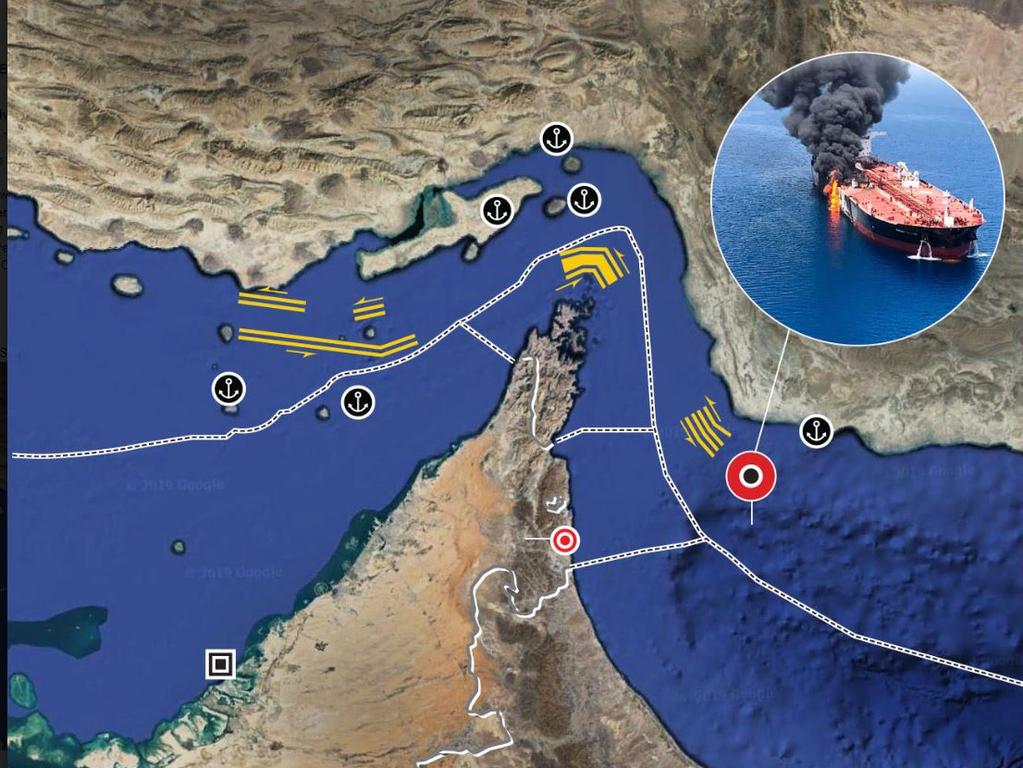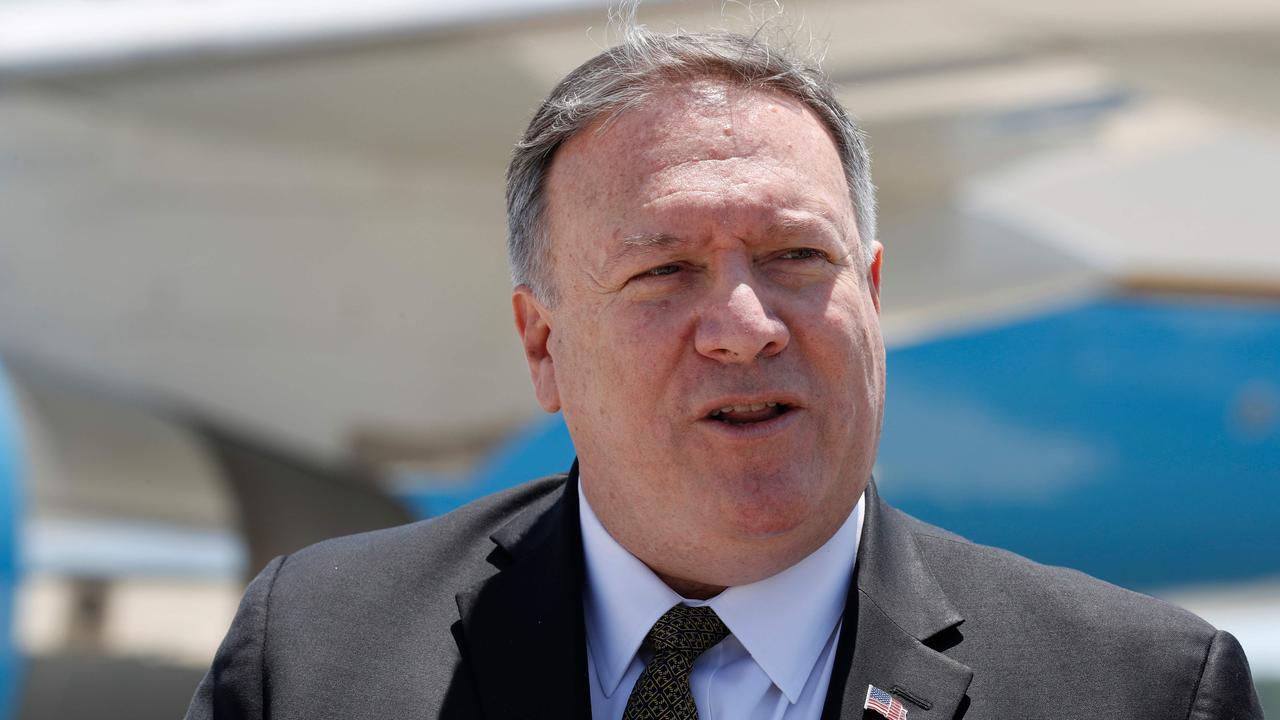Donald Trump has announced new sanctions against Iran. Here’s why Australia should be worried
Donald Trump’s latest move has pushed tensions between the US and Iran to the edge. And Australians are uniquely vulnerable as a result.
Tensions between Washington and Tehran are at an all-time high in what could be one of the worst foreign policy crises of Donald Trump’s career.
Tucked away in the southern hemisphere, it’s easy for Australia to turn a blind eye when these sparring matches occur.
But our nation is in a position to be uniquely affected by the rising tensions.
TRUMP’S CRIPPLING NEW MOVE AGAINST IRAN
The US President overnight announced a move to place even more sanctions on Iran, targeting the country’s senior leaders and military officials.
Mr Trump said he signed an executive order imposing “hard-hitting” sanctions on Iran that will deny Iran’s Supreme Leader Ayatollah Ali Khamenei, his office “and many others” access to financial instruments.
Iran is already heavily sanctioned, and it’s unclear the extent to which the officials targeted will feel the pain, in practical terms.
But it’s a telltale sign that — far from slowing down — tensions between the two countries are set to continue well into the future.
The White House put out a statement overnight urging Iran to give up its nuclear ambitions and to seek renegotiations in “good faith”.
“We call on the regime to abandon its nuclear ambitions, change its destructive behaviour, respect the rights of its people and return in good faith to the negotiating table,” the statement said.
Mr Trump told reporters the sanctions were in part a response to last week’s downing of a US drone by Iran but added they would have happened anyway.
“Today’s actions follow a series of aggressive behaviours by the Iranian regime in recent weeks, including shooting down of US drones,” he said. “The supreme leader of Iran is one who ultimately is responsible of the hostile conduct of the regime. He’s respected within his country. His office oversees the regime’s most brutal instruments, including the Islamic Revolutionary Guard Corps.”
Iran’s Foreign Minister hit back at the US, saying it’s “now clear” the Trump administration “despises diplomacy” and “thirsts for war”.
.@realDonaldTrump is 100% right that the US military has no business in the Persian Gulf. Removal of its forces is fully in line with interests of US and the world. But it's now clear that the #B_Team is not concerned with US interests—they despise diplomacy, and thirst for war.
— Javad Zarif (@JZarif) June 24, 2019
WHY AUSTRALIANS SHOULD BE WORRIED
It may feel like we’re far removed from the angry tweet-offs between the US and Iran.
But with Iran repeatedly threatening to disrupt one-fifth of the world’s oil supply, Australia could be in trouble — and not just because of higher petrol prices.
Since 2012, Australia has been in breach of its international obligations to hold a 90-day minimum of fuel reserves as set out by the International Energy Agency (IEA).
This is basically the amount of crude oil we have onshore that we can dip into or share if the global oil supply faces disruptions.
Based on our current supply, we could only sustain ourselves for 55 days — the only one of the IEA’s 30 member states not meeting its 90-day obligation.

Brendan Thomas-Noone, a research fellow at the United States Studies Centre, warned the Iran-US conflict put Australia in a uniquely vulnerable position.
“Australia does not meet its energy reserve,” Dr Thomas-Noone told news.com.au. “Most of the refined petroleum we get comes from Asia, but all the unrefined fuel comes from the Middle East.
“In a world where things are globalised and interconnected, we’re vulnerable because we’re not investing enough at home.”
In the Lowy Institute Asia Power Index, Australia is ranked 15th out of 25 countries in fuel security. The index also found Australia had the highest net imports of refined petroleum in Asia, hitting $US13.8 billion in 2017.
At the same time, Dr Thomas-Noone noted US Secretary of State Mike Pompeo is going around the Asia-Pacific looking for allies to contribute to a potential maritime security initiative in the Strait of Hormuz — one of the world’s most crucial oil supply routes — to protect shipping.
He believes it’s likely Australia will be asked to donate financial or military resources at a time when we should be focusing on our own region.
Dr Bryce Wakefield, executive director of the Australian Institute of International Affairs, told news.com.au that many of the US’s traditional allies — still committed to diplomacy with Iran — may be reluctant to take part, which would place more pressure on the UK and Australia to do so.
“If Australia does decide to assist the United States in such operations, Canberra needs to stress its actions are designed to uphold freedom of navigation in the region,” he said.
He said Canberra should “certainly not engage in the sort of demonisation of Tehran that we see coming out of the White House”.

Another concern is the role we may play if tensions between the US and Iran escalate into war. According to Dr Thomas-Noone, this is no longer an unlikely prospect.
“The Trump administration’s policy at the moment is forcing that situation,” he said. “I hope there’s no conflict, but Iran’s economy will continue to be constrained over the next few months, and they will continue to feed other avenues to inflict pain on the US and its coalition partners.”
It would take a “realistic dialogue with realistic expectations” to bring that pressure down, Dr Thomas-Noone said. He says this would have to come from the US end, and members of Mr Trump’s administration run a “much more ideological foreign policy” that may not allow for that.

If this trend continues, it could put Australia in a tricky position.
“I think Australia would be in a really tough position if the US took unilateral action and military operations against Iran. I think we would be under pressure to contribute some sort of armed forces initiative … and I think that would be a mistake for Australia to do that,” Dr Thomas-Noone said.
He says Canberra should be sending a clear signal to the US government now — before tensions get any worse — that escalating tensions is not the right course of action and that our focus will be elsewhere.
Dr Wakefield said it’s clear neither side is prepared for a shooting war in Iran, saying there’s a long way to go before that potentially happens.
“It may be that one side miscalculates and bumbles their way into a war, or that the Trump administration, realising that sanctions are not working, attempts a military solution to the problem,” he said.
He said the US would likely call on its allies to legitimise its actions if a sustained war against Iran was to eventually occur.
In this case, Australia would more than likely have to play a role.
“Australia has a doctrine of supporting US combat efforts in conflict far from Australian shores, and would likely commit to maritime operations in the Gulf and special forces activities in conflict.”
WHY ARE THE US AND IRAN FIGHTING IN THE FIRST PLACE?
The latest tensions between the US and Iran aren’t just about a sudden drone strike or a random tweet. They’ve been brewing for many months.
On May 8, 2018, Mr Trump withdrew from the Iran nuclear deal — a multinational deal that would end economy-crippling sanctions on Iran in exchange for it giving up its nuclear weapons.
Two weeks later, on May 21, Mr Pompeo laid out 12 demands for a new agreement with Iran, basically calling on the Iranian government to completely overhaul its foreign policy.
In August that year, the US reimposed its first round of sanctions on Iran, as the nuclear deal was now null and void. In November, it launched a second round. These sanctions were effective — Iran’s unemployment rate now sits around 30 per cent and inflation around 40 per cent.
By this point, policy-wise, relations between the countries were clearly not looking good. Soon after, verbal attacks were thrown into the mix.
In April this year, Mr Trump declared a powerful arm of the Iranian military, its Islamic Revolutionary Guard Corps (IRGC), as a foreign terrorist organisation.
This marked the first time Washington had formally labelled another country’s military a “terrorist group”.
A furious Iran responded by declaring the US a “state sponsor of terrorism” and US forces in the region “terrorist groups”.
On May 20, Mr Trump took to his favourite communication medium to heat things up. The day before, a rocket had landed near the US embassy in Baghdad. We don’t know for sure who was responsible, but the President tweeted a direct warning to Iran:
If Iran wants to fight, that will be the official end of Iran. Never threaten the United States again!
— Donald J. Trump (@realDonaldTrump) May 19, 2019
Iran’s Foreign Minister sparred back with the hashtag #NeverThreatenAnIranian, telling Mr Trump to “try respect”.
Goaded by #B_Team, @realdonaldTrump hopes to achieve what Alexander, Genghis & other aggressors failed to do. Iranians have stood tall for millennia while aggressors all gone. #EconomicTerrorism & genocidal taunts won't "end Iran". #NeverThreatenAnIranian. Try respect—it works!
— Javad Zarif (@JZarif) May 20, 2019
Last week, on June 17, the Pentagon authorised moving an additional 1000 troops to the Middle East.
Three days later, on Thursday morning, Iran shot down a US military surveillance drone. No one died, but they did destroy an expensive piece of equipment.
Mr Trump responded on Friday morning, saying he chose not to respond to Iran with missile strikes because too many lives would be lost.
....proportionate to shooting down an unmanned drone. I am in no hurry, our Military is rebuilt, new, and ready to go, by far the best in the world. Sanctions are biting & more added last night. Iran can NEVER have Nuclear Weapons, not against the USA, and not against the WORLD!
— Donald J. Trump (@realDonaldTrump) June 21, 2019
Instead, the US military targeted Iran with a cyberattack on Friday.
As first reported by Yahoo News, the US used unknown digital weapons to disrupt computers involved in Iran’s missile program as well as the computers of an Iranian spy group linked to supporting strikes on oil tankers. The cyberstrikes were weeks — if not months — in the works.
The Trump administration’s latest round of sanctions suggests there’ll be a lot more hostility to come.



